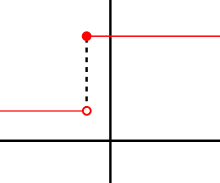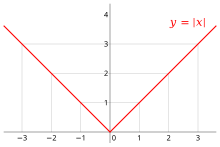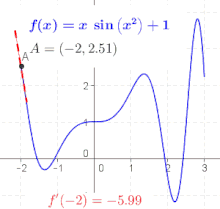The graph of a function, drawn in black, and a tangent line to that function, drawn in red. The slope of the tangent line is equal to the derivative of the function at the marked point.
The derivative of a function of a real variable measures the sensitivity to change of the function value (output value) with respect to a change in its argument (input value). Derivatives are a fundamental tool of calculus. For example, the derivative of the position of a moving object with respect to time is the object's velocity: this measures how quickly the position of the object changes when time advances.
The derivative of a function of a single variable at a chosen input value, when it exists, is the slope of the tangent line to the graph of the function at that point. The tangent line is the best linear approximation of the function near that input value. For this reason, the derivative is often described as the "instantaneous rate of change", the ratio of the instantaneous change in the dependent variable to that of the independent variable.
Derivatives may be generalized to functions of several real variables. In this generalization, the derivative is reinterpreted as a linear transformation whose graph is (after an appropriate translation) the best linear approximation to the graph of the original function. The Jacobian matrix is the matrix that represents this linear transformation with respect to the basis given by the choice of independent and dependent variables. It can be calculated in terms of the partial derivatives with respect to the independent variables. For a real-valued function of several variables, the Jacobian matrix reduces to the gradient vector.
The process of finding a derivative is called differentiation. The reverse process is called antidifferentiation. The fundamental theorem of calculus states that antidifferentiation is the same as integration. Differentiation and integration constitute the two fundamental operations in single-variable calculus.
Differentiation
Differentiation is the action of computing a derivative. The derivative of a function y = f(x) of a variable x is a measure of the rate at which the value y of the function changes with respect to the change of the variable x. It is called the derivative of f with respect to x. If x and y are real numbers, and if the graph of f is plotted against x, the derivative is the slope of this graph at each point.
Slope of a linear function: 

The simplest case, apart from the trivial case of a constant function, is when y is a linear function of x, meaning that the graph of y is a line. In this case, y = f(x) = mx + b, for real numbers m and b, and the slope m is given by
The idea, illustrated by Figures 1 to 3, is to compute the rate of change as the limit value of the ratio of the differences Δy / Δx as Δx becomes infinitely small.
Notation
Two distinct notations are commonly used for the derivative, one deriving from Leibniz and the other from Joseph Louis Lagrange.In Leibniz's notation, an infinitesimal change in x is denoted by dx, and the derivative of y with respect to x is written
In Lagrange's notation, the derivative with respect to x of a function f(x) is denoted f'(x) (read as "f prime of x") or fx′(x) (read as "f prime x of x"), in case of ambiguity of the variable implied by the derivation. Lagrange's notation is sometimes incorrectly attributed to Newton.
Rigorous definition
A secant approaches a tangent when  .
.
 .
.The most common approach to turn this intuitive idea into a precise definition is to define the derivative as a limit of difference quotients of real numbers. This is the approach described below.
Let f be a real valued function defined in an open neighborhood of a real number a. In classical geometry, the tangent line to the graph of the function f at a was the unique line through the point (a, f(a)) that did not meet the graph of f transversally, meaning that the line did not pass straight through the graph. The derivative of y with respect to x at a is, geometrically, the slope of the tangent line to the graph of f at (a, f(a)). The slope of the tangent line is very close to the slope of the line through (a, f(a)) and a nearby point on the graph, for example (a + h, f(a + h)). These lines are called secant lines. A value of h close to zero gives a good approximation to the slope of the tangent line, and smaller values (in absolute value) of h will, in general, give better approximations. The slope m of the secant line is the difference between the y values of these points divided by the difference between the x values, that is,
Equivalently, the derivative satisfies the property that
Substituting 0 for h in the difference quotient causes division by zero, so the slope of the tangent line cannot be found directly using this method. Instead, define Q(h) to be the difference quotient as a function of h:
In practice, the existence of a continuous extension of the difference quotient Q(h) to h = 0 is shown by modifying the numerator to cancel h in the denominator. Such manipulations can make the limit value of Q for small h clear even though Q is still not defined at h = 0. This process can be long and tedious for complicated functions, and many shortcuts are commonly used to simplify the process.
Definition over the hyperreals
Relative to a hyperreal extension R ⊂ ∗R of the real numbers, the derivative of a real function y = f(x) at a real point x can be defined as the shadow of the quotient ∆y/∆x for infinitesimal ∆x, where ∆y = f(x + ∆x) − f(x). Here the natural extension of f to the hyperreals is still denoted f. Here the derivative is said to exist if the shadow is independent of the infinitesimal chosen.Example
The squaring function
The squaring function given by f(x) = x2 is differentiable at x = 3, and its derivative there is 6. This result is established by calculating the limit as h approaches zero of the difference quotient of f(3):
More generally, a similar computation shows that the derivative of the squaring function at x = a is f′(a) = 2a:
Continuity and differentiability
This function does not have a derivative at the marked point, as the function is not continuous there (specifically, it has a jump discontinuity).
If f is differentiable at a, then f must also be continuous at a. As an example, choose a point a and let f be the step function that returns the value 1 for all x less than a, and returns a different value 10 for all x greater than or equal to a. f cannot have a derivative at a. If h is negative, then a + h is on the low part of the step, so the secant line from a to a + h is very steep, and as h tends to zero the slope tends to infinity. If h is positive, then a + h is on the high part of the step, so the secant line from a to a + h has slope zero. Consequently, the secant lines do not approach any single slope, so the limit of the difference quotient does not exist.
The absolute value function is continuous, but fails to be differentiable at x = 0 since the tangent slopes do not approach the same value from the left as they do from the right.
However, even if a function is continuous at a point, it may not be differentiable there. For example, the absolute value function given by f(x) = |x| is continuous at x = 0, but it is not differentiable there. If h is positive, then the slope of the secant line from 0 to h is one, whereas if h is negative, then the slope of the secant line from 0 to h is negative one. This can be seen graphically as a "kink" or a "cusp" in the graph at x = 0. Even a function with a smooth graph is not differentiable at a point where its tangent is vertical: For instance, the function given by f(x) = x1/3 is not differentiable at x = 0.
In summary: for a function f to have a derivative it is necessary for the function f to be continuous, but continuity alone is not sufficient.
Most functions that occur in practice have derivatives at all points or at almost every point. Early in the history of calculus, many mathematicians assumed that a continuous function was differentiable at most points. Under mild conditions, for example if the function is a monotone function or a Lipschitz function, this is true. However, in 1872 Weierstrass found the first example of a function that is continuous everywhere but differentiable nowhere. This example is now known as the Weierstrass function. In 1931, Stefan Banach proved that the set of functions that have a derivative at some point is a meager set in the space of all continuous functions. Informally, this means that hardly do any random continuous functions have a derivative at even one point.
The derivative as a function
The derivative at different points of a differentiable function. In this case, the derivative is equal to:

Let f be a function that has a derivative at every point in its domain. We can then define a function that maps every point
 to the value of the derivative of
to the value of the derivative of  at
at  . This function is written f′ and is called the derivative function or the derivative of f.
. This function is written f′ and is called the derivative function or the derivative of f.Sometimes f has a derivative at most, but not all, points of its domain. The function whose value at a equals f′(a) whenever f′(a) is defined and elsewhere is undefined is also called the derivative of f. It is still a function, but its domain is strictly smaller than the domain of f.
Using this idea, differentiation becomes a function of functions: The derivative is an operator whose domain is the set of all functions that have derivatives at every point of their domain and whose range is a set of functions. If we denote this operator by D, then D(f) is the function f′. Since D(f) is a function, it can be evaluated at a point a. By the definition of the derivative function, D(f)(a) = f′(a).
For comparison, consider the doubling function given by f(x) = 2x; f is a real-valued function of a real number, meaning that it takes numbers as inputs and has numbers as outputs:
Higher derivatives
Let f be a differentiable function, and let f ′ be its derivative. The derivative of f ′ (if it has one) is written f ′′ and is called the second derivative of f. Similarly, the derivative of the second derivative, if it exists, is written f ′′′ and is called the third derivative of f. Continuing this process, one can define, if it exists, the nth derivative as the derivative of the (n-1)th derivative. These repeated derivatives are called higher-order derivatives. The nth derivative is also called the derivative of order n.If x(t) represents the position of an object at time t, then the higher-order derivatives of x have physical interpretations. The second derivative of x is the derivative of x′, the velocity, and by definition this is the object's acceleration. The third derivative of x is defined to be the jerk, and the fourth derivative is defined to be the jounce.
A function f need not have a derivative (for example, if it is not continuous). Similarly, even if f does have a derivative, it may not have a second derivative. For example, let
 is given by
is given by
 , and it does not have a derivative at zero. Similar examples show that a function can have a kth derivative for each non-negative integer k but not a (k + 1)th derivative. A function that has k successive derivatives is called k times differentiable. If in addition the kth derivative is continuous, then the function is said to be of differentiability class Ck. A function that has infinitely many derivatives is called infinitely differentiable or smooth.
, and it does not have a derivative at zero. Similar examples show that a function can have a kth derivative for each non-negative integer k but not a (k + 1)th derivative. A function that has k successive derivatives is called k times differentiable. If in addition the kth derivative is continuous, then the function is said to be of differentiability class Ck. A function that has infinitely many derivatives is called infinitely differentiable or smooth.On the real line, every polynomial function is infinitely differentiable. By standard differentiation rules, if a polynomial of degree n is differentiated n times, then it becomes a constant function. All of its subsequent derivatives are identically zero. In particular, they exist, so polynomials are smooth functions.
The derivatives of a function f at a point x provide polynomial approximations to that function near x. For example, if f is twice differentiable, then
Inflection point
A point where the second derivative of a function changes sign is called an inflection point. At an inflection point, the second derivative may be zero, as in the case of the inflection point x = 0 of the function given by , or it may fail to exist, as in the case of the inflection point x = 0 of the function given by
, or it may fail to exist, as in the case of the inflection point x = 0 of the function given by  . At an inflection point, a function switches from being a convex function to being a concave function or vice versa.
. At an inflection point, a function switches from being a convex function to being a concave function or vice versa.
Notation (details)
Leibniz's notation
The symbols ,
,  , and
, and  were introduced by Gottfried Wilhelm Leibniz in 1675. It is still commonly used when the equation y = f(x) is viewed as a functional relationship between dependent and independent variables. Then the first derivative is denoted by
were introduced by Gottfried Wilhelm Leibniz in 1675. It is still commonly used when the equation y = f(x) is viewed as a functional relationship between dependent and independent variables. Then the first derivative is denoted by
 . These are abbreviations for multiple applications of the derivative operator. For example,
. These are abbreviations for multiple applications of the derivative operator. For example,
 at the point
at the point  in two different ways:
in two different ways:
Lagrange's notation
Sometimes referred to as prime notation, one of the most common modern notation for differentiation is due to Joseph-Louis Lagrange and uses the prime mark, so that the derivative of a function is denoted
is denoted  . Similarly, the second and third derivatives are denoted
. Similarly, the second and third derivatives are denoted
and
or
 for the nth derivative of
for the nth derivative of  – this notation is most useful when we wish to talk about the
derivative as being a function itself, as in this case the Leibniz
notation can become cumbersome.
– this notation is most useful when we wish to talk about the
derivative as being a function itself, as in this case the Leibniz
notation can become cumbersome.
Newton's notation
Newton's notation for differentiation, also called the dot notation, places a dot over the function name to represent a time derivative. If , then
, then
and
 . This notation is used exclusively for derivatives with respect to time or arc length. It is very common in physics, differential equations, and differential geometry. While the notation becomes unmanageable for high-order derivatives, in practice only few derivatives are needed.
. This notation is used exclusively for derivatives with respect to time or arc length. It is very common in physics, differential equations, and differential geometry. While the notation becomes unmanageable for high-order derivatives, in practice only few derivatives are needed.
Euler's notation
Euler's notation uses a differential operator , which is applied to a function
, which is applied to a function  to give the first derivative
to give the first derivative  . The nth derivative is denoted
. The nth derivative is denoted  .
.If y = f(x) is a dependent variable, then often the subscript x is attached to the D to clarify the independent variable x. Euler's notation is then written
or
,
Euler's notation is useful for stating and solving linear differential equations.
Rules of computation
The derivative of a function can, in principle, be computed from the definition by considering the difference quotient, and computing its limit. In practice, once the derivatives of a few simple functions are known, the derivatives of other functions are more easily computed using rules for obtaining derivatives of more complicated functions from simpler ones.Rules for basic functions
Most derivative computations eventually require taking the derivative of some common functions. The following incomplete list gives some of the most frequently used functions of a single real variable and their derivatives. , then
, then
- Exponential and logarithmic functions:
Rules for combined functions
In many cases, complicated limit calculations by direct application of Newton's difference quotient can be avoided using differentiation rules. Some of the most basic rules are the following.- Constant rule: if f(x) is constant, then
for all functions f and g and all real numbers
and
.
for all functions f and g. As a special case, this rule includes the fact
whenever
is a constant, because
by the constant rule.
for all functions f and g at all inputs where g ≠ 0.
- Chain rule: If
, then
Computation example
The derivative of the function given byIn higher dimensions
Vector-valued functions
A vector-valued function y of a real variable sends real numbers to vectors in some vector space Rn. A vector-valued function can be split up into its coordinate functions y1(t), y2(t), …, yn(t), meaning that y(t) = (y1(t), ..., yn(t)). This includes, for example, parametric curves in R2 or R3. The coordinate functions are real valued functions, so the above definition of derivative applies to them. The derivative of y(t) is defined to be the vector, called the tangent vector, whose coordinates are the derivatives of the coordinate functions. That is,If e1, …, en is the standard basis for Rn, then y(t) can also be written as y1(t)e1 + … + yn(t)en. If we assume that the derivative of a vector-valued function retains the linearity property, then the derivative of y(t) must be
This generalization is useful, for example, if y(t) is the position vector of a particle at time t; then the derivative y′(t) is the velocity vector of the particle at time t.
Partial derivatives
Suppose that f is a function that depends on more than one variable—for instance,In general, the partial derivative of a function f(x1, …, xn) in the direction xi at the point (a1, …, an) is defined to be:
An important example of a function of several variables is the case of a scalar-valued function f(x1, ..., xn) on a domain in Euclidean space Rn (e.g., on R2 or R3). In this case f has a partial derivative ∂f/∂xj with respect to each variable xj. At the point (a1, …, an), these partial derivatives define the vector
Directional derivatives
If f is a real-valued function on Rn, then the partial derivatives of f measure its variation in the direction of the coordinate axes. For example, if f is a function of x and y, then its partial derivatives measure the variation in f in the x direction and the y direction. They do not, however, directly measure the variation of f in any other direction, such as along the diagonal line y = x. These are measured using directional derivatives. Choose a vectorIf all the partial derivatives of f exist and are continuous at x, then they determine the directional derivative of f in the direction v by the formula:
The same definition also works when f is a function with values in Rm. The above definition is applied to each component of the vectors. In this case, the directional derivative is a vector in Rm.
Total derivative, total differential and Jacobian matrix
When f is a function from an open subset of Rn to Rm, then the directional derivative of f in a chosen direction is the best linear approximation to f at that point and in that direction. But when n > 1, no single directional derivative can give a complete picture of the behavior of f. The total derivative gives a complete picture by considering all directions at once. That is, for any vector v starting at a, the linear approximation formula holds:If n and m are both one, then the derivative f ′(a) is a number and the expression f ′(a)v is the product of two numbers. But in higher dimensions, it is impossible for f ′(a) to be a number. If it were a number, then f ′(a)v would be a vector in Rn while the other terms would be vectors in Rm, and therefore the formula would not make sense. For the linear approximation formula to make sense, f ′(a) must be a function that sends vectors in Rn to vectors in Rm, and f ′(a)v must denote this function evaluated at v.
To determine what kind of function it is, notice that the linear approximation formula can be rewritten as
In one variable, the fact that the derivative is the best linear approximation is expressed by the fact that it is the limit of difference quotients. However, the usual difference quotient does not make sense in higher dimensions because it is not usually possible to divide vectors. In particular, the numerator and denominator of the difference quotient are not even in the same vector space: The numerator lies in the codomain Rm while the denominator lies in the domain Rn. Furthermore, the derivative is a linear transformation, a different type of object from both the numerator and denominator. To make precise the idea that f ′(a) is the best linear approximation, it is necessary to adapt a different formula for the one-variable derivative in which these problems disappear. If f : R → R, then the usual definition of the derivative may be manipulated to show that the derivative of f at a is the unique number f ′(a) such that
The definition of the total derivative of f at a, therefore, is that it is the unique linear transformation f ′(a) : Rn → Rm such that
If the total derivative exists at a, then all the partial derivatives and directional derivatives of f exist at a, and for all v, f ′(a)v is the directional derivative of f in the direction v. If we write f using coordinate functions, so that f = (f1, f2, ..., fm), then the total derivative can be expressed using the partial derivatives as a matrix. This matrix is called the Jacobian matrix of f at a:
The definition of the total derivative subsumes the definition of the derivative in one variable. That is, if f is a real-valued function of a real variable, then the total derivative exists if and only if the usual derivative exists. The Jacobian matrix reduces to a 1×1 matrix whose only entry is the derivative f′(x). This 1×1 matrix satisfies the property that f(a + h) − (f(a) + f ′(a)h) is approximately zero, in other words that
 is the best linear approximation to f at a.
is the best linear approximation to f at a.The total derivative of a function does not give another function in the same way as the one-variable case. This is because the total derivative of a multivariable function has to record much more information than the derivative of a single-variable function. Instead, the total derivative gives a function from the tangent bundle of the source to the tangent bundle of the target.
The natural analog of second, third, and higher-order total derivatives is not a linear transformation, is not a function on the tangent bundle, and is not built by repeatedly taking the total derivative. The analog of a higher-order derivative, called a jet, cannot be a linear transformation because higher-order derivatives reflect subtle geometric information, such as concavity, which cannot be described in terms of linear data such as vectors. It cannot be a function on the tangent bundle because the tangent bundle only has room for the base space and the directional derivatives. Because jets capture higher-order information, they take as arguments additional coordinates representing higher-order changes in direction. The space determined by these additional coordinates is called the jet bundle. The relation between the total derivative and the partial derivatives of a function is paralleled in the relation between the kth order jet of a function and its partial derivatives of order less than or equal to k.
By repeatedly taking the total derivative, one obtains higher versions of the Fréchet derivative, specialized to Rp. The kth order total derivative may be interpreted as a map
Generalizations
The concept of a derivative can be extended to many other settings. The common thread is that the derivative of a function at a point serves as a linear approximation of the function at that point.- An important generalization of the derivative concerns complex functions of complex variables, such as functions from (a domain in) the complex numbers C to C. The notion of the derivative of such a function is obtained by replacing real variables with complex variables in the definition. If C is identified with R2 by writing a complex number z as x + iy, then a differentiable function from C to C is certainly differentiable as a function from R2 to R2 (in the sense that its partial derivatives all exist), but the converse is not true in general: the complex derivative only exists if the real derivative is complex linear and this imposes relations between the partial derivatives called the Cauchy–Riemann equations – see holomorphic functions.
- Another generalization concerns functions between differentiable or smooth manifolds. Intuitively speaking such a manifold M is a space that can be approximated near each point x by a vector space called its tangent space: the prototypical example is a smooth surface in R3. The derivative (or differential) of a (differentiable) map f: M → N between manifolds, at a point x in M, is then a linear map from the tangent space of M at x to the tangent space of N at f(x). The derivative function becomes a map between the tangent bundles of M and N. This definition is fundamental in differential geometry and has many uses – see pushforward (differential) and pullback (differential geometry).
- Differentiation can also be defined for maps between infinite dimensional vector spaces such as Banach spaces and Fréchet spaces. There is a generalization both of the directional derivative, called the Gâteaux derivative, and of the differential, called the Fréchet derivative.
- One deficiency of the classical derivative is that not very many functions are differentiable. Nevertheless, there is a way of extending the notion of the derivative so that all continuous functions and many other functions can be differentiated using a concept known as the weak derivative. The idea is to embed the continuous functions in a larger space called the space of distributions and only require that a function is differentiable "on average".
- The properties of the derivative have inspired the introduction and study of many similar objects in algebra and topology — see, for example, differential algebra.
- The discrete equivalent of differentiation is finite differences. The study of differential calculus is unified with the calculus of finite differences in time scale calculus.







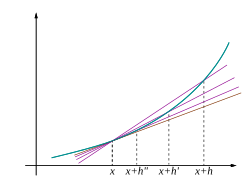
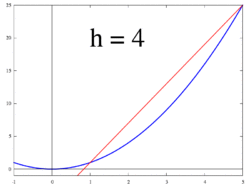






![{\begin{aligned}f'(3)&=\lim _{h\to 0}{\frac {f(3+h)-f(3)}{h}}=\lim _{h\to 0}{\frac {(3+h)^{2}-3^{2}}{h}}\\[10pt]&=\lim _{h\to 0}{\frac {9+6h+h^{2}-9}{h}}=\lim _{h\to 0}{\frac {6h+h^{2}}{h}}=\lim _{h\to 0}{(6+h)}.\end{aligned}}](https://wikimedia.org/api/rest_v1/media/math/render/svg/c937146572a5443c648de2852705afc883b35599)

![{\displaystyle {\begin{aligned}f'(a)&=\lim _{h\to 0}{\frac {f(a+h)-f(a)}{h}}=\lim _{h\to 0}{\frac {(a+h)^{2}-a^{2}}{h}}\\[0.3em]&=\lim _{h\to 0}{\frac {a^{2}+2ah+h^{2}-a^{2}}{h}}=\lim _{h\to 0}{\frac {2ah+h^{2}}{h}}\\[0.3em]&=\lim _{h\to 0}{(2a+h)}=2a\end{aligned}}}](https://wikimedia.org/api/rest_v1/media/math/render/svg/029b05dcc8c1a9d40e75bfcf806cbae45964b0b2)
